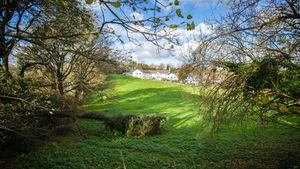Peter Ferbrache: ‘The reality is that it should be built on’
We’re in desperate need of more housing in Guernsey, says Deputy Peter Ferbrache, and building on the hospital field was a ‘no-brainer’...

The main purpose of this article is to try to put some balance in the commentary made about the field at the hospital.
Before I do that, I want to make one or two general comments about housing.
I saw a headline in a national newspaper, which could have been equally applicable to Guernsey, headed: ‘The house shortage is so dire, it’s alienating a generation’.
On the same day I watched an interview between Laura Kuenssberg and cabinet minister Michael Gove. She showed him some statistics which revealed, over less than a generation, the vast increase in the disparity between the growth in average earnings and the cost of housing. What it means, and it is the same here, is we are approaching having a generation of people who will probably not be able to buy their own home.
She also showed him details about social housing (which we used to call council homes) which again emphasised how dire that situation is, and how the gap is growing between need and availability. The whole point of the interview was to show that government after government has failed to do anything to resolve the crisis. The same applies to Guernsey.
I remember when the then much-lauded Island Development Plan was being processed, we were told how flexible it would be and would facilitate development. I have more than 40 years’ experience in monitoring such development plans. It has achieved some improvement, but we have also created a monster. A monster that is not being reviewed fully and within time, and never was going to be, and a monster that now precludes any material deviation from its principles. We tried, when I was president of Policy & Resources, to come up with some sensible solutions to streamline the housing process, and we were met time after time with a sharp intake of breath and statements to the effect of how impossible it all was.
While we do not want to go back to the days of unacceptable ribbon development, which has damaged (but thankfully not destroyed) our beautiful countryside, we have gone too far.
Before moving on I would commend everyone who has the time to read the excellent article about housing that appeared recently in the Guernsey Press by former deputy Andy Le Lievre. I owe Andy a phone call. I will call you, Andy! Please read that article if you have the opportunity.
Anyway, I was also pleased to hear Deputy Trott’s comments about how he hopes there could be spades in the ground before the end of this year with the Leale’s Yard development.
I have been in favour of the Leale’s Yard development since it was first promulgated by the proposed developers. They have come up with good ideas and constructive solutions. I was also at the forefront of the purchases of land at a cost of about £32m. for social housing. I was also a great supporter during my time of the purchase of the Charroterie and Braye Lodge sites and the proposed development at Oberlands.
The truth is stark. We are not building anywhere near the number of social or private housing we need. We are a million miles from where we should be. We have had report after report and policy after policy, but few homes are being built in the private and almost none in the public sectors.
The answer is simple – build more homes. The solutions, though, are difficult, but they are often made much more difficult than they need be.
Enough of the preamble, and I now turn to the field at the Vauquiedor.
When it was purchased more than 90 years ago it was bought at development and not agricultural land prices.
What happened was that our ancestors purchased a whole area of land and had some given to them, which meant that we had enough land to be able to build a hospital with lots of room (then) for expansion.
Of course I accept that just because something was purchased as a potential development a long time ago, does not mean it necessarily needs to be used for that now. Here, though, it does.
My heart sank when I saw Deputies Soulsby and Roffey looking wistfully over a farm gate some time ago with the message, ‘Do not build here’. Both of them are experienced and able politicians, but their judgement on this, as with other deputies of the same view, may be popular but it is poor.
Let me advise you what the reality is.
The field is poor quality agricultural land. It has rarely been used in any meaningful way for farming purposes for a long time and we have a massive unfulfilled need for homes for health care staff.
My involvement with the field began when, together with other deputies, I went to a presentation at the Duchess of Kent. It was led politically by Deputy Brouard, president of the Health & Social Care Committee, and also, among others, Deputy Leadbeater, a member of that committee, who were in attendance, as were their senior officers and advisers. It was pointed out to us in clear terms just how necessary and urgent it was to build accommodation on the field. The alternative was to build on the Duchess of Kent site, which could not happen for years, would provide less accommodation and would cost more. Other developments, admittedly some not in mind at the time such as the Oberlands, would not satisfy the need. Deputy Brouard (and Deputy Leadbeater and the officers) were absolutely certain that the demand by nursing and other health care staff to live in such accommodation would be overwhelming.
Not every nurse wants to live near to their work, we have heard since. I am sure that is right, but there are many who would. When you finish your shift at six o’clock in the morning, the last thing you want to do is get on a bus or even walk any particular distance.
The States has approved the development of phase two of the hospital. That will require, in the next five or six years, an additional 180 staff to service it.
We know that there is already a real difficulty in getting enough good quality staff. Nurses and other health care professionals are in demand everywhere.
‘A no-brainer’ was the comment that came from the meeting I was at. It should be done ‘tomorrow’ was the sentiment. I was not the only States deputy there. One or two who were very much vocally in support of it at the time have since melted away. Well, it is controversial, is it not, and an election looms.
We knew it was going to be difficult to build there because there would be a public outcry, and the zoning by the planners was difficult. The fact it was difficult did not stop it being right. Deputy Brouard and his colleagues were not helped by their predecessors. What HSC should have done was lobby at the IDP stage for the whole of the PEH site to be zoned as flexibly as it could for hospital development. That they did not was short-sighted. As far as I am aware that did not happen and that has restricted what can be done – or at least it has given those who want to oppose it the ammunition to do so.
The reality is it should be built on. It would have provided many homes – relatively quickly.
It would have freed up some properties around the island that are rented by the States for Health & Social Care staff.
I am not an environmental heathen. I do not want us building on green fields unnecessarily. What I want us to do, though, is have regard to practicalities. The realities of life are often not easy. So those who are criticising those of us who tried to solve a problem may be patting themselves on the back, but to what purpose?
I read that the editor of the Guernsey Press in an editorial was critical of the decision we made. Like many others, he is entitled to be wrong. When perhaps in years to come there is a struggle to get nursing staff to treat the sick members of our society, they can look at the green field and wonder how appropriate their comments were. I respect the views of those who were against the development, but I refute them, however well-intentioned they are.
I have no hesitation at all in saying that the field should have been used to provide homes for health care staff. Deputy Brouard was confident the demand would be overwhelming. I am realistic enough to say that, while welcoming the homes to be provided at La Charroterie, Braye Lodge and the Oberlands, they will be nowhere near enough.
We are doing little to solve our desperate, desperate housing situation. To build on that particular field is a million miles away from pouring concrete over every green field in Guernsey to satisfy our housing needs. I do not advocate that and neither do any of my sensible colleagues who supported the views that I and others hold.
So look at that green field as you drive up and down to and from the hospital, and think what should have been.

